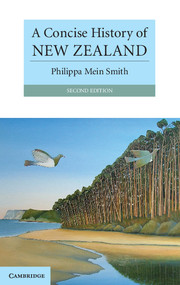Book contents
- Frontmatter
- Contents
- Illustrations
- Acknowledgements
- Preface
- 1 Waka across a watery world
- 2 Beachcrossers 1769–1839
- 3 Claiming the land 1840–1860
- 4 Remoter Australasia 1861–1890
- 5 Managing globalisation 1891–1913
- 6 ‘All flesh is as grass’ 1914–1929
- 7 Making New Zealand 1930–1949
- 8 Golden weather 1950–1972
- 9 Latest experiments 1973–1996
- 10 Treaty revival 1973–1999
- 11 Shaky ground
- Glossary Of maori words
- Timeline
- Sources of Quotations
- Guide to Further Reading
- Index
1 - Waka across a watery world
Published online by Cambridge University Press: 05 October 2013
- Frontmatter
- Contents
- Illustrations
- Acknowledgements
- Preface
- 1 Waka across a watery world
- 2 Beachcrossers 1769–1839
- 3 Claiming the land 1840–1860
- 4 Remoter Australasia 1861–1890
- 5 Managing globalisation 1891–1913
- 6 ‘All flesh is as grass’ 1914–1929
- 7 Making New Zealand 1930–1949
- 8 Golden weather 1950–1972
- 9 Latest experiments 1973–1996
- 10 Treaty revival 1973–1999
- 11 Shaky ground
- Glossary Of maori words
- Timeline
- Sources of Quotations
- Guide to Further Reading
- Index
Summary
How and when did New Zealand begin? Geologically the archipelago dates back 80 million years when it separated from Gondwana. Other than Antarctica, New Zealand was the last major landmass settled by humans. The first settlers, ancestors of the indigenous people, the Maori, are now thought to have arrived in the thirteenth century, whereas people inhabited the rest of the Pacific Rim from 12,000 to an estimated 60,000 years ago. Europeans arrived very late indeed, with planned settlements only from 1840. The two waves of people from Polynesia and Europe in a flash of time transformed the land and remade the landscapes. These simple facts of place and time explain why the environment is so much associated with the nation's culture and identity.
Time before humans
Geographically, New Zealand is an archipelago of many islands, from Raoul in the Kermadec group to Campbell Island, although the three main islands account for almost 99 per cent of the land area of 270,000 square km. Its comparable size to the British Isles is important in a once dominant version of the country's history. Ancestral New Zealand, so scientists tell us, was once part of the great southern continent of Gondwana, its rocks forming a mountainous area stretching along Gondwana's eastern margin, 100 million years ago. Then what is known as the Rangitata landmass broke away and headed eastwards into the Pacific. Ancestral New Zealand was on its own. Flora and fauna have not migrated overland for the last 80 million years, and movement and sea floor spreading ceased about 55 million years ago when the Tasman Sea reached its full width, separating the New Zealand landmass from south-eastern Australia.
- Type
- Chapter
- Information
- A Concise History of New Zealand , pp. 1 - 21Publisher: Cambridge University PressPrint publication year: 2011



